A Guide to Direct Field Acoustic Testing (DFAT®) and Simulation for Aerospace Engineers
The method and purpose of pre-test vibroacoustic analysis

Space presents the ultimate challenge for technology. There are numerous variables impacting spacecraft and their payloads, including the mechanical loads due to launch, vast temperature fluctuations, and radiation. Engineers must demonstrate that the hardware can withstand these environments and continue working as expected to ensure mission success.
Launching a spacecraft requires comprehensive testing to qualify payloads to their requirements. During liftoff, the engines are on full thrust, and the rocket is barely in motion, creating an intense acoustic field that could damage structures. Traditionally, the only way to certify spaceflight hardware meets its acoustic requirements was using reverberant chambers, which is time-consuming, costly, and requires moving hardware to a dedicated site, introducing additional risks.
An alternative approach is to utilize DFAT® testing to ensure the structural integrity of satellite and space hardware under acoustic loading. This method enables engineers to overcome design challenges, speeds up development cycles, and meets regulatory standards.
To delve deeper, I spoke with Alexis Castel, Technical Expert for VA One at ESI, and Arloe "Wes" Mayne, Sr. Staff PM at MSI-DFAT.
Vibro-Acoustic Pre-Test Qualification Practices
Massimiliano: Can you provide an overview of vibroacoustic analysis and how it helps prove that hardware is launch-ready?
Alexis: A vibroacoustic analysis qualifies the interaction between the acoustic output of various systems and the resulting mechanical vibrations. In the space industry, it simulates the aggressive conditions that occur during launch to ensure that spacecraft and payloads remain unaffected.
This involves subjecting hardware and aerospace structures to intense vibration and acoustic loads to understand structural integrity and performance. Engineers can identify potential faults, verify design reliability, meet regulatory standards, and confirm that spacecraft can withstand the harsh dynamic environment. With the high stakes and costs involved, it is mission-critical to ensure that acoustic loading does not negatively impact hardware.
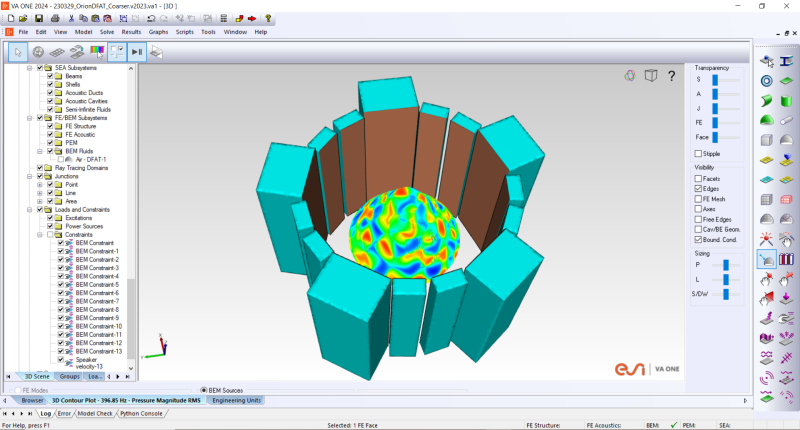
Engineers apply the structural analysis software VA One to prepare for their on-site DFAT® Test, (C) ESI Group (a part of Keysight Technologies), 2025
Massimiliano: How does vibroacoustic testing overcome the challenges presented by using reverberant chambers?
Alexis: Vibroacoustic testing occurs in a lab environment, eliminating the need to utilize dedicated acoustic facilities, which adds significant cost and time constraints to the design process and introduces risk. It enables every organization in the space ecosystem, from startup to legacy entity, to confidently prove the safety and compliance of their designs.
MSI-DFAT®: What is the Method and Purpose of Acoustic Testing for Space Hardware
Massimiliano: Vibroacoustic testing has been increasingly accepted since your first successful proof of concept in 1999. Can you explain MSI's method of Direct Field Acoustic Testing (DFAT) for space hardware?
Wes: MSI-DFAT pioneered the approach, which reproduces launch acoustic environments using loudspeakers surrounding a test article. Engineers create a diffuse acoustic field around a fairing or payload using strategically placed loudspeakers that are controlled to provide test results in a lab environment. This removes the need to use an acoustic reverberant chamber for spacecraft and components.
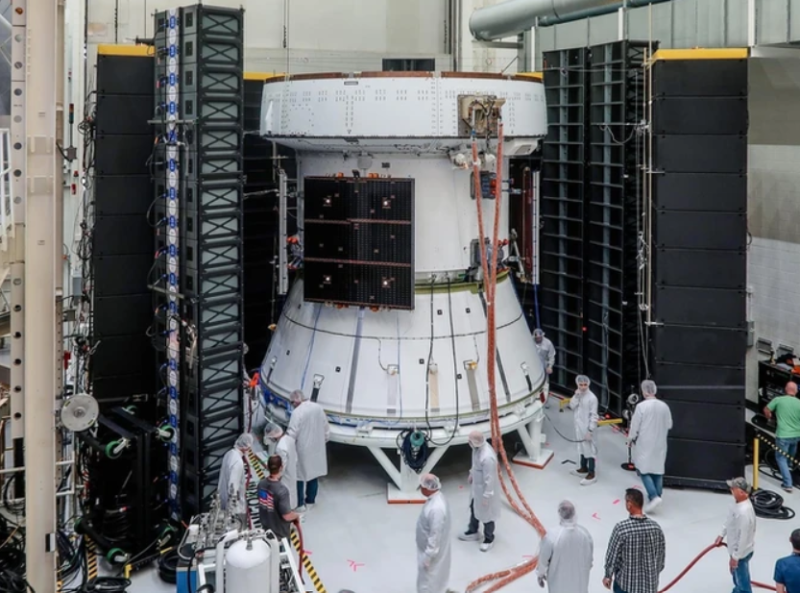
Artemis 2 SM in front of a MSI-DFAT system at Kennedy Space Center in Cape Canaveral Florida, (C) MSI-DFAT
The DFAT testing system is portable, so manufacturers no longer have to travel to an offsite testing facility, subjecting the hardware to the rigors of shipping. Test equipment such as sound systems, power generation and distribution, and control systems are all set up at the customer’s site. This is more convenient, quicker, and done at a significantly lower cost than testing at an offsite reverberant chamber. According to our experience, the U.S. Air Force estimates it has saved approximately $1.25 million using the DFAT method.
Massimiliano: That’s impressive! Can you elaborate on the benefits of DFAT?
Wes: Absolutely. An acoustic reverberant chamber is expensive to build, it must be staffed with specialized personnel and incurs running costs—think of things like a compressed gas system. Technically speaking, acoustic testing in that setting does a poor job of creating the required diffuse acoustic field at low frequencies, which can lead to a significantly different excitation of the test article than desired.
With DFAT testing, there are a number of benefits. From a technical perspective, the MIMO narrow band control ensures the uniformity of the acoustic field from 20 Hz, and testers can also include accelerometers in the control to limit the amount of vibration of the structure.
Optimizing DFAT Testing Requirements with VA One
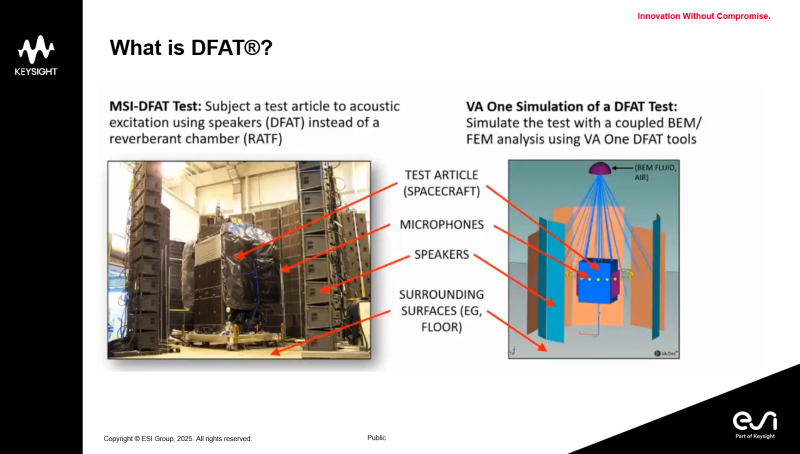
This shows a VA One model of a DFAT test article. (C) ESI (a part of Keysight Technologies), 2025
Massimiliano: Tell us about the relationship between DFAT® and our VA One software?
Alexis: We’ve partnered with MSI-DFAT since 2013 to simulate the characteristics of acoustic fields generated by DFAT tests. The DFAT module within VA One allows companies to optimize their setups. Essentially, we develop a sound generation model that can predict key criteria like the ideal number and type of speakers, control strategy, and test article response, all before the actual physical DFAT testing.
That means, by using VA One, engineers can prepare for their on-site DFAT by simulating a diffuse acoustic field, testing different speaker configurations, evaluating the sound field uniformity, and delivering pre-test structural qualification—without needing specialized acoustic reverberation rooms and avoiding the risks and costs of transporting sensitive components to remote test facilities. This is particularly important when working with a new or unusual test where no previous experience can help foresee unexpected behaviors.
The DFAT Testing & Simulation Process
Massimiliano: How does VA One assist in more efficient qualification testing?
Alexis: The DFAT module within VA One allows engineers to easily model the full vibroacoustic excitation and response of a test article. By simulating the acoustic environment, the platform delivers numerous insights, including predicting the behavior of standing waves, improving sound pressure uniformity, and analyzing complex sound field interactions. This information validates that the field is sufficiently diffuse, providing vital intelligence to increase testing accuracy and efficiency.
The Role of a dedicated DFAT control model
Massimiliano: Can you elaborate on the mathematics involved in DFAT testing and simulation?
Alexis: Of course. A dedicated DFAT control model is key to predicting how the various elements will behave during testing.
A typical DFAT test setup comprises numerous speakers, amplifiers, control microphones and a closed-loop MIMO acoustic control and data acquisition system. We use the Boundary Element Method (BEM) to model these components and employ the Finite Element Method (FEM) to model the test article. This enables engineering teams to evaluate all of the criteria inherent to a successful test and also get ahead of any potential issues that may crop up. We break our DFAT simulation theory down into a three-step process:
- The first involves a mathematical formula that uses the BEM solver to generate two matrices—one represents the transfer function between each acoustic source and the microphone in the model, and the other is the transfer function between each source and a mode on the structure under test. We use cross-spectral matrices to analyze the sound sources and their response. VA One then utilizes this information to calculate excitation metrics, determine the amplitude and cross-correlation between various speaker surfaces, and reproduce the desired acoustic field. However, the initial mathematical model can’t differentiate between amplitude and cross-correlation, which can lead to numerous test inaccuracies.
- The optimization stage is designed to correct this through an algorithm that prioritizes amplitude over cross-correlation as much as the customer desires.
- Finally, we solve the model and perform post-processing. This allows us to measure numerous important metrics—how loud the sound is at different points, how the test article moves or vibrates in response to the sound, and how much stress the sound puts on different parts of the structure, for example.
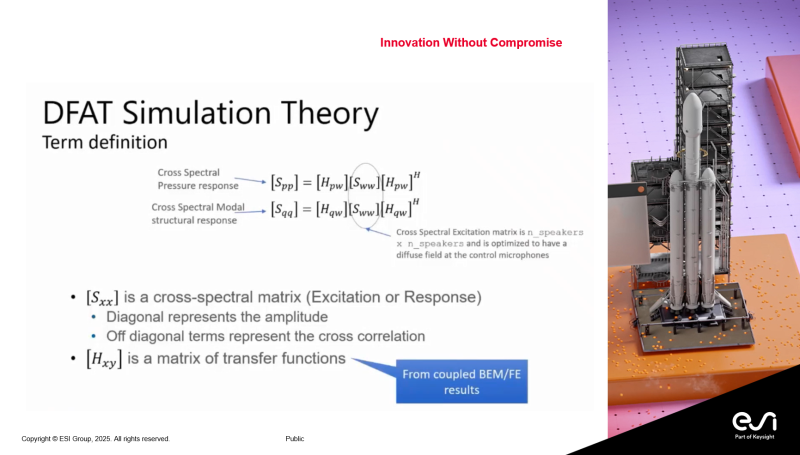
This illustrates the mathematical formula used to simulate a physical DFAT test.
VA One is an all-in-one solution for simulating noise and vibration across the full frequency range for both interior and exterior scenarios. This enables engineers to investigate potential threats and ensure structural integrity during launch, flight, and deployment. More specifically, customers use VA One to:
- determine the Sound Pressure Level (SPL) that the payload will have to sustain.
- use Ray Tracing to evaluate acoustic loads on the fairing.
- evaluate hardware response to the environmental loads experienced during all stages of flight.
- establish pre-flight comparisons to determine the optimal structural configuration.
When it comes to qualification by analysis, the onus is on manufacturers to demonstrate software accuracy and prove that results are correct. This is often a resource-intensive effort that involves searching for papers to support the findings, but VA One significantly reduces this legwork. ESI has a legacy of publishing technical papers on their space-specific research results that spans four decades. This provides extraordinary confidence that ESI’s simulation accurately aligns with testing results. Accuracy breeds trust, and VA One’s proven methodology is a testament to what is possible.
Arloe "Wes" MayneSr. Staff PM at MSI-DFAT
The Advantages of VA One for the Space Industry
Massimiliano: Let’s delve into VA One a bit further. What’s unique about the software specifically for aerospace structures?
Alexis: VA One enables engineers to meet their requirements by providing numerous capabilities designed specifically for space applications. The platform allows engineers to model complex dynamic environment loads efficiently and predict vibrations, acoustics, and shock responses with singular accuracy. In tandem with physical testing, this ensures that spacecraft will survive all of the critical stages of operation—from launch and liftoff through to separation and re-entry. Engineers can also use VA One to assess astronaut comfort and safety criteria in human-rated spacecraft.
NASA, the European Space Agency, Boeing, Raytheon, and Northrop Grumman all utilize VA One for Space Structural Qualification. The simulation enables these and other space companies to prove that the analysis is correct, the software is accurate, and that similar analyses have been correct. VA One customers can capitalize on ESI’s repository of technical research that goes back 40 years. To put it simply, this gives them confidence that their simulation results align with testing results.
As space missions become more frequent and complex, the challenge of testing payloads and launch vehicles intensifies. Accelerated launch schedules compress design cycles, limiting time for thorough vibro-acoustic analyses. The variety of launch vehicles, each with unique acoustic and vibrational profiles, further complicates testing. Accurate and proven simulation software enables space companies to enhance collaboration between payload and vehicle teams, optimize resource allocation, and empower engineers to validate new space technologies' robustness within constrained timelines and budgets.
With VA One, engineers can tackle these challenges, achieve faster development cycles, and ensure their designs comply with stringent launch certification requirements. VA One is changing traditional ways of working towards more digitalized qualification and certification of virtual spacecraft or payload prototypes without sacrificing safety and robustness. The software gives engineers confidence their tests will be successful.
Massimiliano: This has been such an interesting discussion—Wes and Alexis, thanks so much for your time.
Accelerating Space Designs with Vibroacoustic Pre-Test Analysis
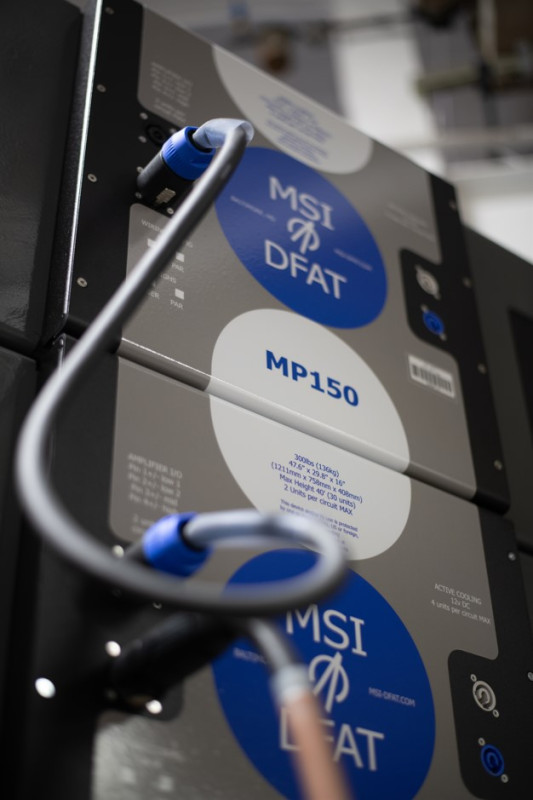
MSI-DFAT Test Equipment, (C) MSI-DFAT
It’s clearly an exciting era in the space industry, with advancements in material science, artificial intelligence, and 3D printing among the trends ushering in new possibilities. Before these innovations can have an impact, stakeholders must be confident in their ability to withstand not only the harsh environment of space but also the challenging conditions of getting the payload there in the first place.
This is why vibroacoustic pre-test analysis is critical and will play a more prominent role in the coming years. In this environment, the DFAT module within VA One enables engineers to qualify new designs more efficiently and accurately while ensuring compliance with the industry’s stringent standards.
Now, take your expertise further by joining our webinar, where Alexis will break down Low Frequency Acoustic Analysis with FEM-BEM in VA One.
About Arloe "Wes" Mayne
Arloe "Wes" Mayne, III, Senior Staff PM/Engineer at MSI DFAT, has nearly 40 years of experience in test facility development and aerospace acoustic testing. Working at MSI-DFAT, he manages large-scale DFAT projects, provides vibroacoustic support, and leads customer interactions, DFAT system R&D, and modeling.
DFAT is a registered trademark of MSI-DFAT.
Dott. Ing. Massimiliano Calloni is the Senior Product Marketing Manager for ESI Group, where he plays a pivotal role in shaping the future of vibro-acoustic simulation technology. With a Master’s degree in Aerospace Engineering from the prestigious Politecnico di Milano, Massimiliano brings over two decades of deep expertise in Noise & Vibration. His career includes six years at AgustaWestland Helicopters, where he excelled as a consultant in both testing and simulation. Today, he leverages his extensive technical knowledge and marketing acumen to drive the global success of ESI’s VA One software, supporting strategic initiatives worldwide.